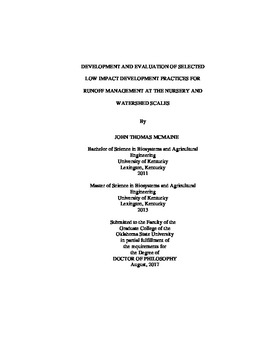| dc.contributor.advisor | Vogel, Jason R. | |
| dc.contributor.author | McMaine, John Thomas | |
| dc.date.accessioned | 2018-04-23T19:35:41Z | |
| dc.date.available | 2018-04-23T19:35:41Z | |
| dc.date.issued | 2017-12 | |
| dc.identifier.uri | https://hdl.handle.net/11244/299529 | |
| dc.description.abstract | Agricultural and urban runoff can threaten water resources. Land disturbances related to urbanization and agriculture can change hydrologic characteristics such as volume of runoff and peak flow. In addition, activities related to urbanization and agriculture can increase pollutants such as pesticides and nutrients present in runoff. The goal of this research was to evaluate and develop selected low impact development practices for management of runoff in two different settings, plant nurseries and urban areas. The specific objectives were: (1) Evaluate pesticide, nutrient, and sediment removal performance of two different types of constructed wetlands (one subsurface-flow and one free-surface) at two nurseries in Oklahoma; (2) Examine the effects of saturation conditions and irrigation patterns on pesticide removal using a lab-scale column study; and, (3) Develop a simple tool that enables practitioners with limited technical expertise to quickly and easily determine optimal combinations of LID practices that optimizes runoff reduction and cost. The pollutant removal performance evaluation of the two constructed wetlands demonstrated that both systems effectively reduced nutrients in runoff, but pesticide reduction was variable. The subsurface-flow constructed wetland significantly reduced most of the commonly seen pesticides however, pesticide removal was variable in the free-surface constructed wetland and no pesticide compound exhibited mass reduction that was statistically significant. While the lab-scale column study was exploratory in nature, results indicated higher pesticide removal under certain hydrologic patterns. There was a general trend indicating that holding water within the column system for a longer time increased removal efficiency. There was no indication that saturation conditions (fully saturated vs variably saturated) impacted pesticide removal. Finally, the optimization procedure addressed a need for developers and smaller municipalities that want to implement low impact development practices to reduce runoff while minimizing cost. The procedure used available software that did not require significant expertise in programming or hydrology, Microsoft Excel and the EPA Stormwater Calculator. Users could determine combinations that met different hydrologic or cost goals by modifying the objective function and/or constraints. Overall, meeting each research objective contributed to the overarching goal of reducing the impact of agricultural and urban runoff on water resources. | |
| dc.format | application/pdf | |
| dc.language | en_US | |
| dc.rights | Copyright is held by the author who has granted the Oklahoma State University Library the non-exclusive right to share this material in its institutional repository. Contact Digital Library Services at lib-dls@okstate.edu or 405-744-9161 for the permission policy on the use, reproduction or distribution of this material. | |
| dc.title | Development and evaluation of selected low impact development practices for runoff management at the nursery and watershed scales | |
| dc.contributor.committeeMember | Brown, Glenn O. | |
| dc.contributor.committeeMember | Belden, Jason B. | |
| dc.contributor.committeeMember | Schnelle, Michael A. | |
| osu.filename | McMaine_okstate_0664D_15404.pdf | |
| osu.accesstype | Open Access | |
| dc.type.genre | Dissertation | |
| dc.type.material | Text | |
| thesis.degree.discipline | Biosystems and Agricultural Engineering | |
| thesis.degree.grantor | Oklahoma State University | |
